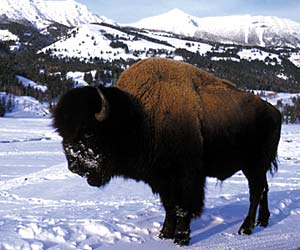Federal agencies, Montana reach agreement on Yellowstone bison
The US Department of the Interior's National Park Service and the USDA's APHIS and Forest Service announced an agreement Dec 20, 2000 on a Joint Management Plan for bison in Yellowstone National Park and Montana. The plan is designed to preserve the largest wild, free-ranging population of bison in the United States while minimizing the risk of brucellosis disease transmission (between bison and cattle) to protect the economic interest and viability of the livestock industry in Montana. By allowing bison the opportunity to seek critical winter range outside the park, the plan reflects a commitment on the part of the agencies to end the unnecessary killing of bison outside Yellowstone. It is the result of more than eight years of negotiation and seven months of mediation between the federal agencies and the state of Montana. Although the Joint Management Plan is not intended to be a brucellosis eradication plan, it uses many tools to manage and reduce the risk of brucellosis transmission from bison to cattle. Limited numbers of bison will be allowed on public lands outside the park during winter when cattle are not present. Bison will not be allowed to intermingle with cattle and will be hazed back into the park when the weather moderates in the spring (mid-April on the north side and mid-May on the west side). The agencies will capture or remove bison still remaining outside the park that cannot be hazed. Risk to cattle will be further minimized before they are allowed to return to public lands by waiting a sufficient amount of time to ensure that the bacteria that cause the disease are no longer alive outside the park. The agencies will further manage the risk of transmission of brucellosis to cattle by limiting the number of bison outside the park in the north (Reese Creek) and west (West Yellowstone) management areas through intensive monitoring and hazing, and when necessary, capture, test, and slaughter of seropositive bison. Management activity will be increased as bison move toward the edges of management zones outside the park. The plan also provides that the agencies will maintain a spring bison population of up to 3,000 animals. The agencies also agree to increase implementation of nonlethal management measures, should severe winter conditions result in a large management removal or natural winter die-off. To further reduce the risk of transmission and protect cattle, the agencies will require vaccination if 100 percent of all vaccination-eligible cattle in the north and west management zones are not voluntarily vaccinated within one year. The USDA-APHIS will pay for all direct vaccination costs. Allowing untested bison outside the park in the north and west boundary management zones will begin after the agencies have had experience with seronegative bison in certain areas outside the park during winter, and when the National Park Service initiates vaccination of bison with a safe and effective vaccine using a safe remote delivery system inside the park. As a legislative consultant to the AVMA, former US senator from Montana, Dr. John Melcher, Washington, DC, has for several years worked to promote interagency cooperation and vaccination of bison calves in Yellowstone with RB-51 vaccine. The latter issue is still not resolved in the Joint Management Plan. "We are relieved this much has been accomplished," Dr. Melcher said, "but we don't think the National Park Service should wait any longer to build immunity by vaccinating all the bison calves within Yellowstone Park. Good veterinary medicine does apply to wild herds. Six years ago the National Park Service wanted to be sure of the RB-51 vaccine's efficacy and safety. While we still have tests running to see how much good RB-51 will do, its efficacy and safety have been established." As evidence, Dr. Melcher cited a private bison herd of 3,500 in South Dakota that was heavily infected with brucellosis. State veterinarian, Dr. Sam Holland reports that immunizing the calves with RB-51 over the past six years has been a strong factor in stamping out all infection. "Sam told me that the bison calves in this herd get three doses of RB-51, which has been necessary to completely clean up this herd," Dr. Melcher said. "Even before I was first elected to the House of Representatives in 1969, I had been watching the Yellowstone bison herd. Montana cattle are brucellosis-free, but the Yellowstone bison are heavily infected and are a threat to cattle and people. After all these years, we're just now getting close to a brucellosis control program for Yellowstone bison. It's about time." | ||
